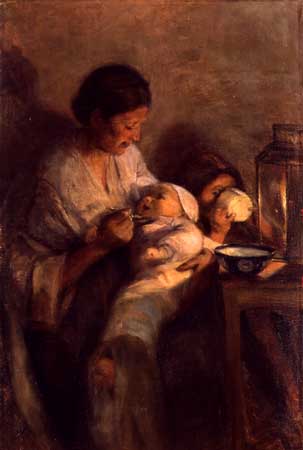ELIZABETH NOURSE: LE
GOUTER

The rich darkness of the
background draws viewers
in to the point where they feel as if they are
included
in the room, able to see clearly the inherent beauty
of a
mother tending to her children. Nourse’s painting
engages by its
treatment of universal themes, moving
in their simplicity.
One of the most popular
paintings in the Brauer Museum of Art’s permanent collection is Le Gouter, an 1893 oil on canvas
painting by Elizabeth Nourse (1859-1938). This lovely work was
for many years in the collection of the Art Institute of Chicago.
Percy Sloan, the generous donor whose 1953 gift of art to Valparaiso
University formed the basis of the museum collection, acquired the
Nourse from the Art Institute in 1950. Sloan then donated this
work and others (including many by his father Junius R. Sloan,
1827-1900) in hopes that students and community members could learn
from fine, original works of art.
Nourse, a native of Cincinnati, Ohio, spent
most of her career in France painting pictures of the domestic scenes,
usually involving women and children.. Le Gouter, French for a light snack
between lunch and dinner, offers a warm depiction of a mother and child
accompanied by a little girl who drinks from her cup. The tender
mood of the painting testifies to Nourse’s considerable skills as a
keen observer of human interaction.
While art critics and historians are
customarily quick to place individual works in the contexts of art
historical movements or schools, such an approach seems almost
unnecessary or oddly inappropriate in relation to Le Gouter (although the painting is
indeed a cultural product and ultimately requires categorization or art
historical categorization, especially in a museum environment).
That is, while the work does relate stylistically to art movements
before and during its making, it seems to speak primarily to the heart
instead of the mind. The deep umber tones certainly remind one of
the baroque depths in Rembrandt’s paintings and countless Madonna and
Child depictions from the Italian Renaissance. Yet viewers are
easily able to shift from this intellectual understanding when standing
before this nearly life-size scene. The rich darkness of the
background draws viewers in to the point where they feel as if they are
included in the room, able to see clearly the inherent beauty of a
mother tending to her children. Nourse’s painting engages by its
treatment of universal themes, moving in their simplicity.
The warmth of the painting has two aspects or
dimensions, and the way in which both of these aspects meld together
contributes to the painting’s effectiveness. The color scheme
Nourse uses consists mainly of shades of brown, with the edges
delineating forms softened to the point of their being nearly
indistinct in certain areas. Through such an approach, the artist
conveys an appearance and overall mood of a dimly lit interior that
subtly glows with layered tones, all arising from the warm end of the
spectrum. The closeness of the figures arranged in the vertical
composition contributes to this atmosphere of coziness within a
darkened space. Additional feelings of warmth from the piece come
from emotions and instincts found deeply within viewers
themselves. The tableau Nourse presents, showing nourishment
taking place on both physical and spiritual levels, has the remarkable
power to produce an actual sensation of warmth in the viewer. The
joy seen in the faces of mother and child as they look at one another
is a powerful reminder of feelings of love and trust that lie within
the human psyche, perhaps embedded more deeply than memories of
individual experiences. Such a primary, fundamental comprehension
of and appreciation for the scenario Nourse depicts has a calming
effect, enabling viewers to forget the distractions of daily life and
become more aware of the basic elements of a flesh and blood existence.
Viewer engagement on aesthetic, emotional, and
even physical levels is further produced by the direct eye contact that
the little girl in the painting establishes with viewers. The
small detail of the girl’s eye peeking past her cup is easily missed
when one first sees the work. However, this beautiful and
sensitive detail energizes the painting in the most fascinating
way. No longer is Le Gouter
an impersonal work of art that is content and self-contained in its
existence on a gallery wall. Instead, it is a moment made
tangible and somehow existing beyond or outside of time, much like a
prehistoric insect frozen in a block of amber. Within the picture
frame, within the glazes of the pigment, the little girl still lives
and playfully wonders who all the people are standing there and
watching her mother and new sibling. Her
curious gaze leads viewers to consider the idea that perhaps looking at
more of a reflective activity than they would imagine. The
pleasant surprise of catching the little girl’s eye is emphasized by
viewer recognition and remembrance of similar glances both seen in
other children and experienced personally. The little girl in
Nourse’s painting is someone with which nearly all can identify; she is
a specific child who, through the artist’s masterful handling of her
medium and subject, metaphorically becomes an embodiment of the wonder
of youth, a wonder that is often poignant for older eyes to
behold.
The artist’s many years in France seem to have
given her the emotional distance necessary in art to see a subject for
its true nature. Le Gouter’s
depths provide a comfortable antidote to the struggles of modern
life. Nourse’s artfully worked canvas surface functions much like
a mirror surface, where viewers are miraculously able to see themselves
as human beings motivated by the same desires and impulses asthose
observed in the artist’s tender portrait.
© by Gregg Hertzlieb



![]()
![]()
![]()
![]()